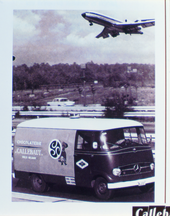

This article has multiple issues. Please help improve it or discuss these issues on the talk page. (Learn how and when to remove these template messages)
|
 | |
Native name | Callebaut |
|---|---|
| Company type | PLC |
| ISIN | BE0933072291 |
| Industry | Chocolate |
| Predecessor | Chocolaterie Callebaut |
| Founded | 1911 |
| Founder | Octaaf Callebaut |
| Headquarters | , |
Area served | Global |
| Products | Couverture chocolate |
| Parent | Barry Callebaut |
| Website | www.callebaut.com |
Callebaut is a Belgian coverture chocolate manufacturer owned by the Barry Callebaut group and based in Belgium. It was founded in 1911 by Octaaf Callebaut in Belgium. Coverture chocolate contains high amounts of cocoa butter and is often used by gourmet and culinary professionals. Many professionals who use Callebaut coverture chocolate use it for its workability and consistent taste.
The company's core chocolate range is manufactured in Belgium from bean to chocolate according to traditional recipes. For over 100 years, Callebaut has used the whole-bean roasting technique, rather than just roasting cocoa kernels. This technique allows preservation of all flavors and aromatic oils within the cocoa husk and fully releases them in the chocolate.[1]

Chocolaterie Callebaut was established in 1911[2] by Octave Callebaut in Wieze, Belgium. His chocolate company used the same factory building his grandfather Eugène Callebaut founded as a family-run brewing and milling company called De Ploeg in 1850.
Although the factory site in Wieze already functioned as a brewery, founded in 1850 by Eugène Callebaut, it was Octaaf Callebaut who began producing chocolate bars there in 1911 and couverture chocolate by 1925.[3]
Octave Callebaut's chocolate recipes found liking by numerous chocolatiers, bakers and pastry chefs.[citation needed] As a result, Chocolaterie Callebaut PLC was established in 1930. A clear focus towards the professional market took shape and the company from then on dedicated its activities to supplying and servicing chocolatiers, confectioners and bakeries.

After Octave Callebaut's death, his daughter Marie and his nephew Charles Callebaut took over the company in 1945. After World War II, the production of coverture chocolate became the company's core business, complemented by a limited range of bars and tablets. Callebaut began offering chocolate for artisan chocolatiers around the world, and the company's W2 reference[clarification needed] was created.
By 1965 Callebaut coverture chocolates had entered new markets across Europe and overseas, starting Callebaut's global expansion.
By 1988, the company was producing callets, small drop-shaped chocolate pieces designed to optimize the workability of chocolate. Dosing, melting and tempering work better with smaller drops than with the original 5 kg (11 lb) blocks of chocolate.
In the same year Callebaut established the Callebaut College in Belgium. The college is a teaching and training center for artisans and professionals who want to improve their working skills in chocolate and learn about new trends, techniques and recipes. It was the first of the thirteen Callebaut Chocolate Academies located all over the world.

In 1996, Callebaut merged with French chocolate maker Cacao Barry to form the Barry Callebaut group. However, both chocolate brands still remain separate under the Barry Callebaut umbrella, with Callebaut as its premium couverture chocolate brand for Belgian Chocolate.
In 2002, Callebaut created the Callebaut Ambassador Club to support the development of new products, packaging, recipes and professional training events. The club has 55 members worldwide consisting of renowned chefs, pastry chefs and confectioners.[citation needed] In the same year, Callebaut, together with chocolate brands Carma and Cacao Barry, organized the World Chocolate Masters for the first time. The World Chocolate Masters are the only international competition in the world solely dedicated to the art of chocolate. The competition is held every two years.
In 2005 Barry Callebaut was noted as "the world's biggest chocolatier".[4]
In May 2012, Callebaut was Belgium's first chocolate brand to start the use sustainably grown cocoa for all of the Belgian Chocolate recipes. Callebaut launched the Growing Great Chocolate program to help make cocoa cultivation a sustainable source of income for West African farmers and to make a positive impact on their living conditions.[5][6] Though repeated claims have been made by Callebaut, and in particular its subsidiary Cacao Barry, to eliminate the use of child labor in its supply chain, their self-imposed deadline for accomplishing this has been repeatedly pushed back since the early 2000s and is now being slated for 2025.[7]
Callebaut was Belgium's first chocolate brand to partner directly with cocoa farmers and cooperatives to grow cocoa beans sustainably through its Growing Great Chocolate program.[citation needed]
Callebaut is the first chocolate manufacturer in the world and the first food manufacturer in Belgium to obtain the ISO-9002 certificate for its constant care for quality.[citation needed]
In 1990, Callebaut was the first chocolate manufacturer in the world and the first food manufacturer in Belgium to obtain the ISO-9002 certificate for its constant care for quality. Over the following years, Callebaut received a variety of other quality certificates, including: